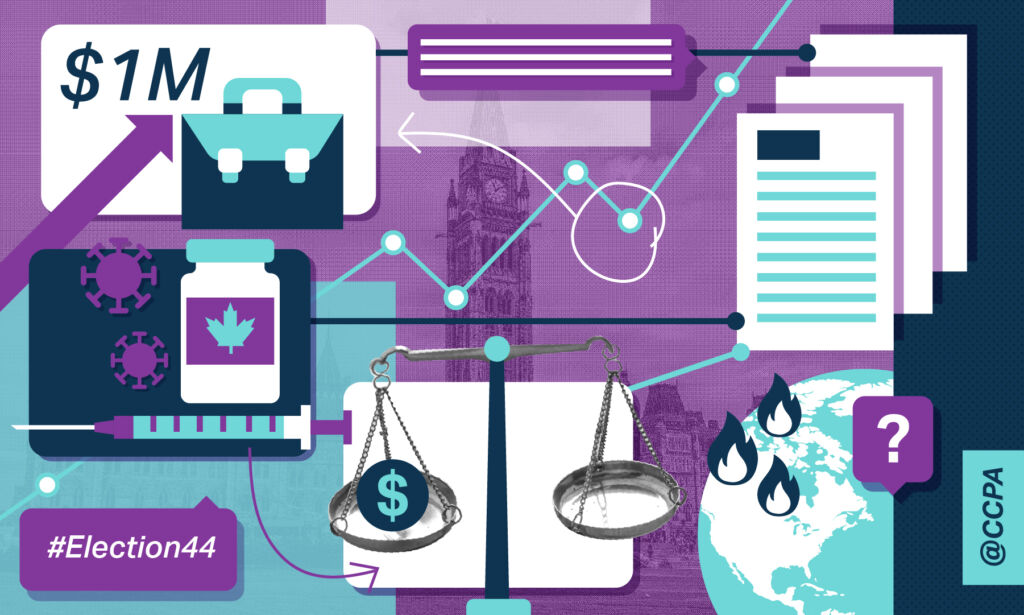It’s rare to see one party release its election commitments so early in a campaign, much less two.
The federal Conservatives are now second out of the gate with their commitments, releasing their platform on Monday based on five planks: jobs, accountability, “secure the country”, mental health, and the economy.
(See our assessment of the NDP commitments here, as part of our ongoing non-partisan analysis of party platforms)
Like the NDP, the Conservatives offer a broad array of commitments, ranging from bread-and-butter conservative issues such as “red tape reduction” and law-and-order issues (like “securing our border”) to newer commitments, such as requiring gig economy companies to make contributions to CPP and Employment Insurance (EI) premiums as part of “a new, portable Employee Savings Account every time they pay their workers.”
Some of the big ticket items in this platform include: large increases to military spending, which could cost upwards of $20 billion more a year; higher health care transfers and equalization payments to the provinces; doubling the Canada Workers Benefit; and an expanded child care expense deduction. There are few money-raising proposals, outside of cancelling the $10-a-day child care plan that is being negotiated with a number of provinces.
The platform commits to greater support for re-opening businesses, including a large expansion of the small business loan program and tax credits for Canadians who spend money at food and accommodation businesses (similar to those already in existence both federally and provincially).
The Conservatives also commit to workers on EI receiving 75% of previous earnings (instead of 55%) during recessions. Improving the replacement rate is something that we’ve detailed in our Alternative Federal Budget, although we’ve suggested it be permanent, not just during recessions. In the end, businesses have received 50% more support than jobless workers so far through the pandemic ($180 billion vs. $120 billion).
As for job creation, the Conservatives promise to create one million of them. Job creation is a worthy goal, but some basic numbers: between February and April 2020, Canada lost 2.99 million jobs. Between April and July 2021, Canada regained 2.74 million jobs. Canada is still down a quarter of a million jobs compared to February 2020, but the most recent numbers are from July and they’ll likely improve in August, as Canada further re-opens its economy. So even if governments did nothing at all, we’d easily be within striking distance of getting all the pandemic jobs back by September (barring more lockdowns).
COVID-19 response
On COVID-19, one point of consensus seems increasingly clear: the mainstream political parties are promising to ensure that Canada is better prepared for future pandemics. How we get there differs in the details.
Like the NDP, the Conservatives promise to stockpile PPE and to ensure Canada has the ability to make needed supplies and vaccines domestically—although the NDP commits to make vaccine production a public entity while the Conservatives appear to be choosing the private path by partnering with pharmaceutical companies (an approach that was taken this year by the federal government, which it announced agreements with two U.S.-based vaccine manufacturers to produce COVID-19 and mRNA vaccines in Canadian facilities).
In fact, under a section entitled “strengthening Health Canada,” the Conservatives promise to “partner with the private sector rather than over-rely on government”—which could portend privatization of aspects of Canada’s public, universally accessible health care system.
Care economy and women’s employment
The Conservative platform includes proposals to boost women’s employment, which declined during the pandemic, and to shore up Canada’s tattered care economy. Its focus on women’s employment is a departure for the party: “women” appeared only seven times in the 100-plus page platform 2019, and gender equality wasn’t referred to at all. This year, the party is supporting targeted investments for hard-hit sectors, such as hospitality and tourism—which are large employers of women workers—and new investments in training, with an emphasis on “traditionally underrepresented groups.”
The party is also proposing to boost funding for child care to enable more women to take up paid employment. Here we are on more familiar territory. There is a clear battle of ideas around child care shaping up, with the promise of the Conservatives to cancel the $10-a-day plan for universal child care promised by the Liberal Party and the NDP—just as they did in 2006. In its place, this time around, the Conservative Party is proposing to replace the Child Care Expense Deduction with a refundable tax credit, covering up to 75% of child care expenses up to a maximum of $6,000 for families earning less than $150,000/year. This credit is modelled on a similar Ontario program, which was introduced in 2019, that delivers an average of $1,300 to families.
This battle of ideas about gender equality and care has been ongoing for decades. What we know from studies in Quebec, which has both $8.75-a-day child care and a generous tax credit regime for those paying for for-profit care, is that it’s two-to-three times cheaper for middle class families to be in an $8.75-a-day spot than in the for-profit system—even after taking the tax credit into account. Moreover, the quality of care is lower in the for-profit system in Quebec, despite costing parents more.
It’s difficult to imagine how Canada can bring about meaningful change for families and advance women’s economic security without the resources and the will to make it happen.
At a system level, a tax credit does nothing to cap fee increases, which CCPA research shows have been galloping ahead of inflation for years. In almost every big city, for-profit care has higher fees than non-profit care. Flooding more money into the private care market only drives up costs for parents and it does nothing to build affordable high-quality services in communities that need it most. Offering cash incentives to parents—inevitably too small—won’t fix this problem. If this was so, we wouldn’t be in the situation we are in today. There’s a reason why the Quebec government is happy to take new funding to expand its high-quality, fixed-fee system: demand has exploded over the past year.
It’s difficult to imagine how Canada can bring about meaningful change for families and advance women’s economic security without the resources and the will to make it happen. The different policy options on offer, of course, aren’t inherently progressive or regressive. Rather, it all comes down to their vision and design, which is why it is so critically important to unpack the ideas about gender, family and government that inform each proposal—and to look at what kind of money is on the table.
This is also crucial to moving forward with reforms to Canada’s grievously flawed system of long-term care. On this key file, the Conservative party is proposing to target $3 billion of infrastructure funding over the next three years to help renovate facilities and to bring in a new Canada Seniors Care Benefit, paying $200 per month per household to any person living with and caring for a parent over the age of 70. A Conservative government will also prioritize immigrants applying to work as Personal Support Workers in long-term care or home care.
Every senior and person with a disability has the right to access the care they need to live with dignity. Both paid and unpaid caregivers—who are overwhelmingly women—deserve more respect and support. Yet these proposals barely scratch the surface of what’s needed to transform a system that was already struggling before COVID-19 hit—a system that has been drained and strained by austerity measures and privatization over the past two decades. Experts agree that national standards on quality care are essential. So, too, is improving conditions of employment and the wages of care workers, which are grossly inadequate across the care economy.
These services are, of course, largely under provincial jurisdiction, but the federal government can, and should, set the bar to provide the necessary resources to meet the needs of an aging population and to end for-profit service delivery. Policy responses that fall short will only deepen existing gender and racial inequities that prop up the current system at devastating cost to those who rely on care and their caregivers.
The Conservative Party is also proposing a much larger funding envelope for strengthening mental health and addictions services, boosting the annual growth rate of the Canada Health Transfer to at least 6% and dedicating a portion of these funds to mental health. Likewise, the NDP has committed to making large scale investments in mental health, extending mental health care for uninsured Canadians as a first step and establishing a new national pharmacare program that would expand access to crucial medications. This is the scale of investment needed to drive change. Where these parties differ is in approach, with Conservatives favouring untied funds and private market delivery and the NDP favouring strong public services.
Climate emergency
Notably absent from the Conservative’s five-point platform summary is any mention of climate change—the number one issue for Canadians. However, the document itself does include a comprehensive climate plan, most of which was released earlier this year. Independent analysis at that time suggested the Conservative plan offered emissions reductions over the next 10 years that are comparable to the current government’s policies.
Emissions reductions in the Conservative plan hinge mainly on a zero-emission vehicle mandate by 2030, an enhanced Low Carbon Fuel Standard and energy efficiency retrofits for buildings. These are smart and proven policies, although most other parties have since made similar commitments.
The Conservative plan is mainly distinguished by its enthusiastic support of lower-carbon fossil fuel production and carbon offsets in lieu of actual reductions in oil and gas production. The plan includes $5 billion for carbon capture technology and $3 billion for natural carbon sinks. Indeed, in its energy section, the platform commits to build even more oil pipelines and subsidize offshore oil wells in a bid to increase production. The plan aims to streamline new extractive projects by paring back environmental assessments and criminalizing protests of “critical infrastructure” that includes railways and pipelines.
When it was released in April, the Conservatives’s plan for carbon pricing was widely panned as being both convoluted and ineffective, yet its proposed “Personal Low Carbon Savings Account” survives in the platform. In short, a CPC government would maintain a relatively low carbon price with revenues directed into individual saving accounts for consumers to spend on “things that help them live a greener life.” This introduces logistical headaches—such as who manages the accounts and what qualifies as “green” spending—and rewards consumers for buying fossil fuels. It’s unlikely to reduce fossil fuel emissions at all.
The upshot is an approach to climate change that may very well get Canada to its inadequate 2030 target, which is progress for the Conservative Party. However, continuing to sink money into fossil fuel infrastructure in the next 10 years will make achieving net-zero emissions by 2050 significantly more difficult.
In the context of last week’s devastating IPCC report, Canada has no excuse for dragging our feet on the phase out of fossil fuels.
Housing
On housing, the Conservative platform bets heavily on supporting the real estate industry while failing to explain how such support would translate into lower rents for low- and moderate-income tenants or reasonable prices for first-time home buyers.
The platform conveys a sense of urgency in dealing with Canada’s housing crisis, but most of the measures proposed would take many years to realize and would have a small impact on market dynamics that are driving prices up.
The platform’s main plank is to “build 1 million homes in the next three years.” To achieve this goal, the Conservative Party promises to “build transit infrastructure that connects homes and jobs by bringing public transit to where people are buying homes.” If those homes already exist, and people are already buying them, it is unclear how improving transit will increase supply. The second part of this proposal is to require municipalities receiving federal funding to increase density near new transit—something municipalities already do. In practice, this requirement would create few, if any, new net units. And, as we know too well, projects involving the building of transit are likely to take more than three years to see the light of day.
The plan for building one million homes in three years also includes land transfer initiatives, the release of federally owned real estate properties, and the conversion of unneeded office space into housing. These ideas aren’t new. A priori, some of them could have a positive impact on the supply of housing, but the platform lacks the level of specificity that would make them concrete proposals. The plan also includes a measure that would allow deferring capital gains tax when selling rental properties and reinvesting in rental housing. This is a fiscal incentive to people and corporations trading and flipping rental units—how this would have a positive impact on families renting those units is unclear.
A second set of proposals focus on corruption activities and foreigner speculation driving up housing prices. While the dismantling of money laundering and terrorism financing schemas are goals worth pursuing, these targeted law enforcement measures will not have a notable impact on a housing market of more than 14 million households. In turn, foreign buyers arguably contribute to fast-rising housing prices, according to recent empirical research. Some provinces are already dealing with the problem. The effect of additional federal measures on market dynamics should not be overstated.
Like the Liberal Party and the NDP, the Conservative Party didn’t resist the temptation of offering cheaper and easier-to-get mortgages to first-time home buyers. This is not the place to unpack this broader and fundamental issue; suffice to say that making it easier for families to take on ever-larger debt is no solution to housing insecurity.
Trade
The Conservative Party traditionally positions itself as the party of free trade and this platform is no exception. While it’s true that almost all of Canada’s free trade and investment agreements were initiated by Conservative governments—including the Comprehensive and Progressive Agreement for Trans-Pacific Partnership (CPTPP) and Canada–EU Comprehensive Economic and Trade Agreement (CETA)—the trade-related promises in this platform are mostly appendages to current international talks and developments.
For example, the Conservative platform promises to continue trade and investment negotiations with India and “[a]nimate the full potential of the Canada-UK trade deal.” The current government is already trying to conclude a free trade agreement with India and is about to start negotiating a post-CETA deal with Britain. The current government also launched free trade talks with Indonesia this year, but this free trade agreement is not mentioned in the Conservative platform.
Domestically, the platform promises to convene a First Ministers’ meeting to “help move negotiations forward” on “interprovincial trade barriers.” However, the Canadian Free Trade Agreement (CFTA), which the Harper government negotiated with the provinces to “modernize” the 1995 Agreement on Internal Trade, has been in force since 2017. (Read the CCPA’s short assessment of the CFTA and the myth of interprovincial trade barriers here.) What more could there be to talk about?
The Conservative Party is proposing to introduce an Admitted Free Act, “clarifying” Section 121 of the constitution with respect to interprovincial trade in the wake of a 2018 Supreme Court ruling on cross-border beer sales. That ruling irritated Canadian libertarians (and their U.S. funders) because it reasserted democratic sovereignty and policy space in areas of provincial jurisdiction (in this case, New Brunswick’s liquor control regime) over newer “free market” concepts, such as “non-tariff barriers to trade,” locked into free trade deals. You can read about that decision, and the anti-democratic implications of any effort to overturn it, on the CCPA Monitor website.
By and large, though, the Conservative platform offers a status quo vision for trade policy.
Like the NDP platform released last week (see the “Fair trade” section on page 36), the Conservatives are also proposing to update Canada’s trade remedies policy. In a section called “Supporting Workers,” the Conservatives propose to “give unions standing at the Canada International Trade Tribunal to allow them to bring actions on issues like dumping.”
This proposal, which is supported by labour unions in Canada, would give unions similar rights as in the United States to request investigations into the dumping of surplus foreign products at below-market prices on the Canadian market. On its own, though, a trade remedies update will not fix the corporate bias in Canada’s trade deals, which give investors hard and enforceable rights while putting hurdles in front of effective worker- and climate-focused policy.
By and large, though, the Conservative platform offers a status quo vision for trade policy: protection of supply managed farming sectors, new markets for Canada’s export-oriented farming sectors, a promise to “[r]esolve the Softwood Lumber Dispute with the United States” (good luck to them), and much closer trade, security and digital policy co-ordination with “free” (suspiciously white and anglo) countries such as Australia, New Zealand, Ukraine and the U.K.
It’s worth noting that Canada’s trade record under CETA, a very status quo deal, isn’t great, as a 2019 CCPA analysis pointed out. That deal, negotiated while the Conservative leader was parliamentary secretary for trade, prohibited “Buy Canadian” conditions on public spending—proposed in both the Conservative and NDP platforms—in most instances. It’s too bad because local spending conditions, especially on big infrastructure projects, can multiply the economic and social benefits of government stimulus.
Fiscal considerations
Like the NDP, the Conservatives released commitments without a full costing, which will be forthcoming as the Parliamentary Budget Officer reviews party proposals. Without detailed costing in this platform release, it’s difficult to say this for sure, but it appears that the Conservatives don’t actually plan to cut spending to balance the books more quickly.
The platform commits to reduce the federal deficit by almost 90%—but the deficit was already set to decrease by 91% ($31 billion by 2025-26), based on the spring budget. If anything, this could mean a slightly higher deficit than the one planned in the latest federal update.
As far as we can tell, there aren’t substantial new taxes to pay for new proposed expenditures or proposed tax cuts, like the December GST holiday. There is some broad agreement now that hiring more CRA auditors for high net worth filers, as well as taxing foreign corporations to avoid tax shifting, is an idea worth pursuing, although an OECD-wide minimum tax for corporations of 15% isn’t something the platform endorses. Hiring new auditors would pay for itself in new revenue. There would be some revenue in taxing foreign corporations. But, overall, the Conservative platform is light on something they have been known for: boutique tax cuts. Perhaps the end of an era?
When the full platform costing comes out, it’s possible that the cancellation of the $10-a-day child care plan is the biggest single funder of the Conservative platform. The proposed new refundable child care credit is likely worth roughly what would be saved by cancelling the present child care expenses deduction. Therefore, the cancellation of the $10-a-day funding would largely go to pay for other measures. Although as noted above, we may well see a larger, not smaller, deficit when everything is counted in the final costed document.
The CCPA has done extensive research and analysis on a wide range of federal policy issues, most notably through our annual Alternative Federal Budget. During the federal election, we’ll be sharing our independent, non-partisan analysis and fact-checking of campaign promises and platforms from all the major parties as they are released.



















